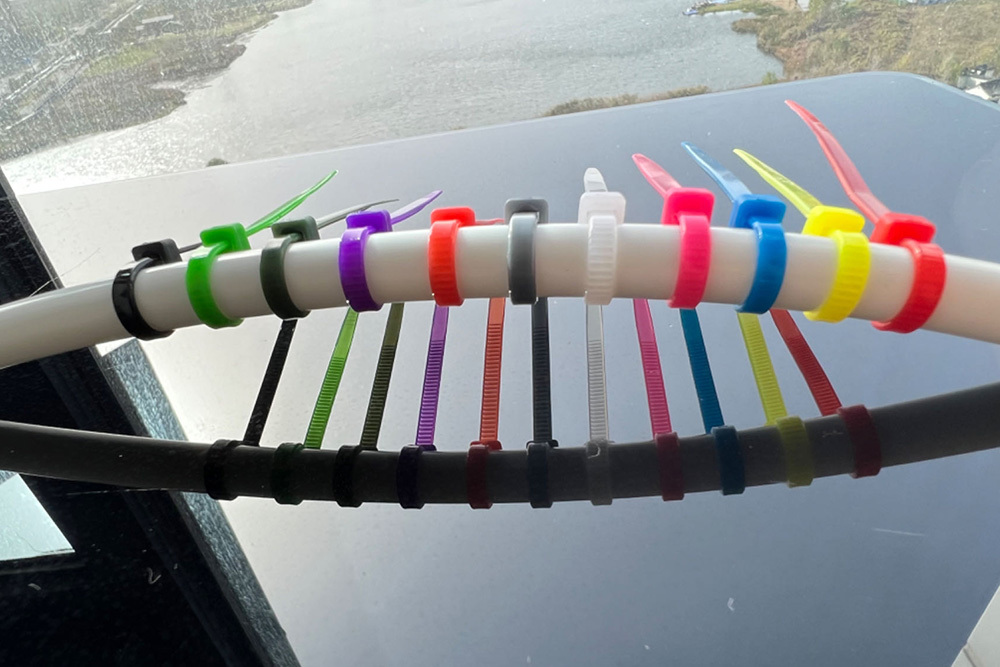11
2025
-
08
Plastic cable ties are used to fix flower branches
Author:
Using Plastic Zip Ties to Secure Floral Stems: A Detailed Guide for Gardeners and Florists
Whether training climbing plants, supporting delicate blooms, or arranging cut flowers, plastic zip ties offer a flexible and durable solution for stabilizing stems. This method is particularly useful for outdoor gardens, trellises, or floral displays where traditional ties may degrade quickly. Below is a step-by-step approach to ensure stems remain securely in place without causing damage or restricting growth.
Selecting the Right Zip Tie Size and Material
Choose zip ties based on the thickness and flexibility of the stems you’re working with. Thinner, more delicate stems require narrower ties to avoid cutting into the plant tissue, while thicker or woody stems can handle wider, sturdier options. Opt for UV-resistant zip ties for outdoor use, as these withstand sunlight and weather exposure better than standard varieties.
Avoiding Over-Tightening
When securing stems, leave a small gap (about 1–2 mm) between the tie and the plant. This prevents constriction, which can hinder water flow or cause swelling as the stem grows. For young or rapidly growing plants, check ties regularly and adjust tension as needed to accommodate new growth.
Positioning Zip Ties for Optimal Support
For climbing plants like roses or ivy, attach zip ties to trellises, stakes, or wire frames at regular intervals. Start near the base of the plant and work upward, spacing ties every 6–12 inches depending on the stem’s weight and flexibility. Ensure the tie sits just below a leaf node or branch point, as these areas are stronger and less likely to snap under pressure.
Supporting Heavy Blooms or Fruit
When stabilizing stems bearing large flowers or fruit, use a figure-eight pattern with two zip ties. Loop one tie around the stem and the support structure, then cross a second tie over the first to create an “X” shape. This distributes weight evenly and reduces the risk of the stem bending or breaking.
Securing Cut Flowers in Arrangements
For floral designs, zip ties can keep stems aligned in vases or floral foam. Gather 3–5 stems of similar length and wrap a tie around the base, just below the bloom. Trim excess tail length to maintain a neat appearance. For cascading arrangements, attach individual stems to a wire frame or driftwood using short ties, ensuring they angle downward naturally.
Preventing Slippage in Water
If submerging tied stems in water, ensure zip ties are tightly fastened to prevent loosening. However, avoid clamping the ties too close to the cut end, as this may block water uptake. For long-lasting displays, replace ties every few days if they show signs of weakening or discoloration.
Protecting Stems from Damage During Fastening
To minimize friction, place a small piece of soft material, such as cloth or garden tape, between the stem and the zip tie. This is especially important for thin-skinned plants like lilies or orchids, which bruise easily. For rough or textured stems, like those of sunflowers, skip the liner but handle the tie gently to avoid scraping the surface.
Adjusting Ties as Plants Grow
Periodically inspect zip ties on living plants for tightness or signs of girdling. Loosen or replace ties that appear embedded in the stem or are causing visible stress marks. For seasonal plants, remove ties after flowering or fruiting to allow stems to return to their natural shape.
Creative Applications for Zip Ties in Floral Design
Use zip ties to attach stems to unconventional supports, such as mason jars, wooden crates, or hanging baskets. For example, secure a bundle of dried flowers to a wreath frame by looping ties through the frame’s gaps and around the stems. This method allows for intricate designs without the need for specialized tools.
Combining Zip Ties with Other Materials
Enhance stability by pairing zip ties with twine, raffia, or floral wire. Wrap twine around the stem first, then secure it with a zip tie for added strength. This hybrid approach works well for outdoor installations exposed to wind or rain, as it combines the flexibility of natural materials with the durability of plastic.
By following these techniques, gardeners and florists can create secure, visually appealing displays that highlight the beauty of the stems and blooms. Proper use of zip ties ensures plants remain healthy while providing the support they need to thrive in any setting.
plastic cable ties
Previous Page
Next Page
Previous Page
Next Page
Hot News
2025-08-13
Make simple hooks with plastic cable ties
Plastic zip ties, commonly used for bundling or securing items, can be repurposed into functional hooks with minimal effort. Their durability and adjustable design make them ideal for hanging lightweight objects like keys, tools, or kitchen utensils. Below are step-by-step methods to craft zip tie hooks for various spaces and needs.
2025-08-13
Temporary repair methods for plastic cable ties
Plastic zip ties, often found in toolkits or junk drawers, are versatile tools for addressing unexpected repairs. Their strength, adjustability, and ease of use make them ideal for temporary fixes when traditional materials aren’t available. Below are practical ways to leverage zip ties for emergency repairs across various scenarios.
2025-08-12
Application of plastic cable tie storage and organization
Plastic zip ties, commonly used for securing items, are versatile tools for tackling clutter in garages, kitchens, offices, and craft rooms. Their durability, adjustability, and low cost make them ideal for creating custom storage systems without specialized equipment. Below are innovative ways to integrate zip ties into your organizational routines.
2025-08-12
Tips for packaging gifts with plastic cable ties
Plastic zip ties, often overlooked in gift-wrapping, offer a unique blend of strength and flexibility for securing packages, adding decorative elements, or creating custom shapes. Whether you’re wrapping irregularly shaped items, bundling multiple gifts, or adding a modern twist to traditional designs, these tips will help you achieve professional-looking results without specialized tools.

